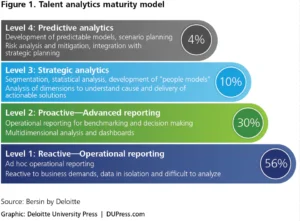How often do you think organizations use talent analytics today? More often than you may think. We know everyone talks about data. Whether you’re figuring out how to acquire new users or build an audience with content, you’re probably using analytics to set goals and measure what’s working. But it is a critical area where both qualitative and quantitative data continue to make a difference in the world of work.
At its most helpful, talent analytics takes the guesswork out of hiring the right talent. Talent analytics doesn’t just help you get a warm body in a seat, either. This data can help recruiters and companies ensure a talent match where only the most motivated and those inspired to do their best work sign the dotted line.
When it comes to world-class recruiting in an increasingly competitive landscape, talent analytics plays a central role in making HR and recruiting work smarter. Think of it as a way out of the HR fog.
That said, understanding the right metrics is key to narrowing down the focus. By applying talent analytics, you can better pinpoint and hire team members who will ultimately serve as positive assets to the organization
What Is Talent Analytics?
Talent analytics is not just data. It’s the term for a data-focused approach to decision-making about current and future employees. By analyzing past employee behavior to predict future performance, talent analytics is often used by HR, hiring managers, and recruiters to find the best type of candidate.
According to Deloitte, “Four percent of organizations surveyed believe they have predictive talent analytics capabilities today. Only 14% of companies have any form of talent analytics program in place. Yet, more than 60% want to build a plan this year.
In a classic Harvard Business Review article about competing on talent analytics, Tom Davenport, Jeanne Harris, and Jeremy Shapiro outlined 6 types of data used for managing a workforce:
6 Types of Data Used for Managing a Workforce
- Human Capital Facts: The key indicators of the business’s health, such as headcount, turnover rate, and employee satisfaction.
- Analytical HR: Segmented data on the units, departments, and individuals that most need attention.
- Human-Capital Investment Analysis: Tracks the activities that have the largest impact on the business, such as how employee satisfaction results in higher revenue, lower costs, and greater employee retention.
- Workforce Forecasts: Identifies and predicts the best times to either ramp up or cut back on staff.
- Talent Value Model: Provides information on why employees want to stay in an organization or why they choose to leave.
- Talent Supply Chain: Predicts how to best staff a company according to changes in the business.
Levels of insight vary – from basic information to predictive modeling. As organizations integrate talent analytics into their practices, deeper insights allow for better planning.

What Moneyball Taught Us About Analytics
Using data gathered from your current workforce can drastically improve your ability to make smarter decisions when recruiting talent. Relying solely on your gut to make a hiring decision is a mistake.
I like to compare talent analytics to the more commonly known practice of sports analytics. This was made famous by the book and film Moneyball. It transformed the way professional baseball teams recruit talent. Instead of relying on gut instincts and old-fashioned scouting, Billy Beane and Peter Brand transformed recruiting by using something now known as “sabermetrics.”
The Oakland Athletics used empirical analysis of baseball statistics to measure in-game activity and predict future performance. Once laughed at by old-school baseball managers, sabermetrics is now used by every team in the Major Leagues.
Just like Beane and Brand, organizations can use talent analytics to hire the right people. Additionally, it can help companies better understand how to align strategy and employee capabilities. It can help make decisions on how and where to allocate human capital across the organization much more reliable. And this makes it much easier to be effective at placing individual employees in the optimal role.
Talent Analytics: Art or Science?
As much as I strongly believe in the power of data, I would never advise someone to rely solely on data to quantify and qualify a human being.
In my opinion, stellar recruiting is an art as much as it is a science. Using data and analytics as business intelligence is powerful, but your value judgment is also fundamental in this process. If talent is a natural ability, it is impossible to precisely quantify. Plus, talent doesn’t (usually) stagnate. It grows and changes, so you need to take that into consideration when assessing data.
Talent analytics has proven to be a powerful business asset. It lets HR and recruiting teams better connect with organizational goals. By helping you clarify the skills and capabilities and performance levels you you’re seeking and achieving, talent analytics can save your organization time and resources. But like any tool, it is most powerful when used in combination with human understanding, organizational context and situational nuance. The ability to measure and leverage people data is not only exciting but smart business.
Post Views: 4,871